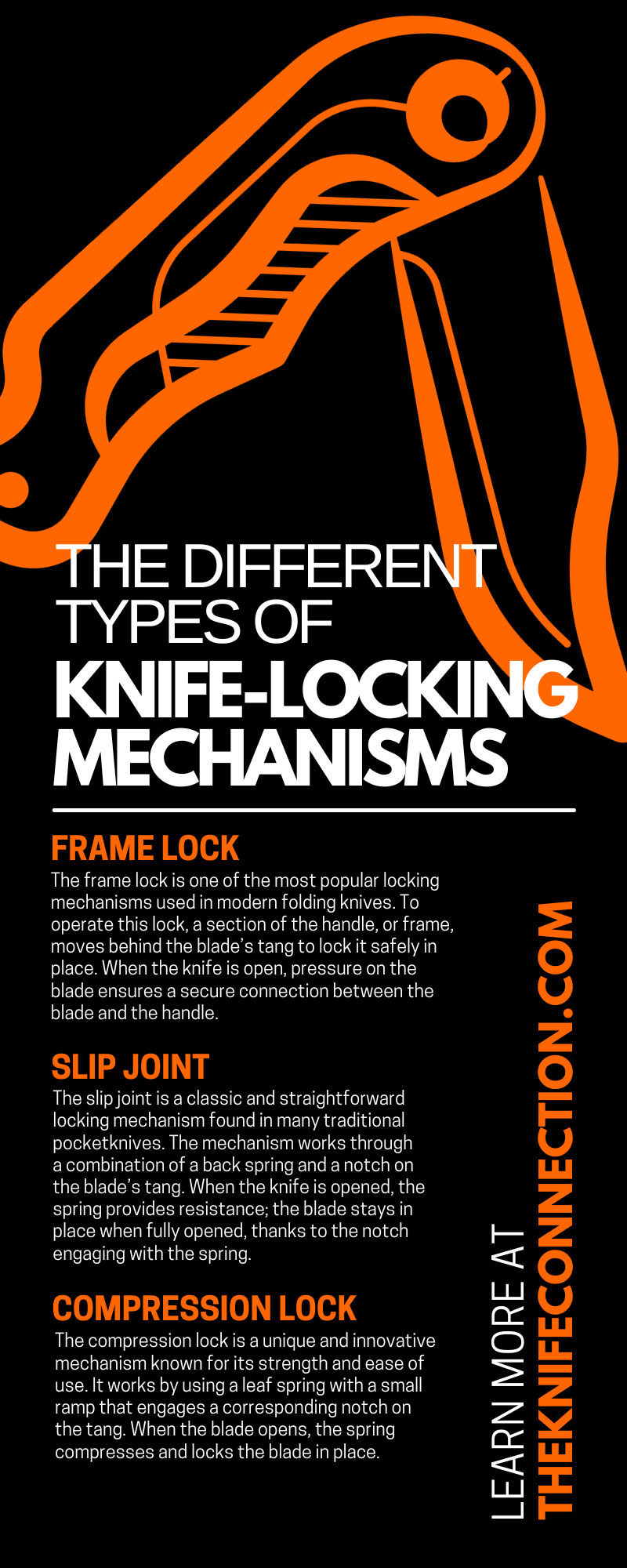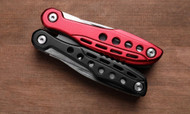The Different Types of Knife-Locking Mechanisms
Oct 12 2023 - 10:13
When it comes to folding knives, one aspect you should never overlook is the knife-locking mechanism. A reliable and robust lock is essential for the performance and safe use of your knife. If you weren’t aware that there are different types of locks, this guide is here to teach you about the various types of knife-locking mechanisms, providing insight into how each one works.
Frame Lock
The frame lock is one of the most popular locking mechanisms used in modern folding knives. To operate this lock, a section of the handle, or frame, moves behind the blade’s tang to lock it safely in place. When the knife is open, pressure on the blade ensures a secure connection between the blade and the handle.
To disengage the lock, simply apply pressure to the opposite side of the frame, allowing the blade to fold back into the handle. The frame lock offers a secure hold and enables easy use, making it a frequent choice among knife enthusiasts. If you’re searching for new knife scales for sale, make sure you consider whether your knife has this type of locking mechanism before making a purchase.
Liner Lock
Similar to the frame lock, the liner lock is another widely used knife locking mechanism that secures the knife blade when it’s in the open position by utilizing a spring-loaded liner inside the knife handle. As the blade is opened, the liner moves beneath the blade’s tang, locking it into place.
To unlock the blade, you can push the spring-loaded liner to the side and fold the blade back into the handle. This mechanism is well-suited for one-handed operation and provides a solid lock-up, making it another favorite among knife users.
Slip Joint
The slip joint is a classic and straightforward locking mechanism found in many traditional pocketknives. The mechanism works through a combination of a back spring and a notch on the blade’s tang. When the knife is opened, the spring provides resistance; the blade stays in place when fully opened, thanks to the notch engaging with the spring.
While a slip joint provides enough support for light tasks, it’s worth noting that it isn’t the most secure locking mechanism, as no actual lock holds the blade in place. As such, slip joint knives are not recommended for heavy-duty applications where a high degree of force may be applied.
Compression Lock
The compression lock is a unique and innovative mechanism known for its strength and ease of use. It works by using a leaf spring with a small ramp that engages a corresponding notch on the tang. When the blade opens, the spring compresses and locks the blade in place.
To disengage the lock, you simply push the spring to the side, allowing the blade to close. The design of the compression lock ensures your fingers stay clear of the blade’s path when closing the knife. Because of that, this locking mechanism is perfect for one-handed operation.
Button Lock
The button lock mechanism is designed for ease of use and quick blade deployment, featuring a button prominently placed on the handle. When they press the button, the user releases a locking mechanism that securely holds the blade in an open or closed position.
Releasing the blade is as simple as pressing the button again and folding the blade. This type of lock is easy to manipulate, provides a secure hold, and is commonly spotted in automatic and assisted-open knives.
Lever Lock
The lever lock mechanism utilizes a rotating lever to keep the knife blade safely locked in an open or closed position. By lifting the lever, the user can release the blade and open the knife. Once the lever is in the open position, pressure on the blade keeps the knife securely locked.
To close the knife, lift the lever again and fold the blade back into the handle. This type of lock offers a secure hold and quick blade deployment, making it popular among knife collectors who use their knives often.
Ring Lock
The ring lock mechanism offers a simple yet highly effective way to secure the blade. It consists of a metal collar or ring that rotates around the handle of the knife. When opening the blade, you can swivel the ring to lock the blade in place; simply move the ring back to close it again.
Due to its simplicity and inherent strength, the ring lock mechanism is highly durable and reliable, making it an excellent choice for everyday carry and general-purpose knives. Additionally, the ring lock is easy to operate with one hand, making it a convenient choice for various tasks.
Back Lock
The back lock, also known as a lock back, is a widely used locking mechanism. It features a spine-mounted lock bar that engages with a notch on the blade’s tang when the knife is opened. To disengage the lock, press down on the exposed end of the lock bar on the handle’s spine, freeing the blade to close.
The back lock is highly regarded for its simplicity, reliability, and strength. It’s an excellent choice for everyday carry knives and versatile enough to handle a wide range of tasks, from outdoor adventures to general utility use.
Tri-Ad Lock
The Tri-Ad lock, designed by renowned knife maker Andrew Demko, is a modification of the traditional back lock. This locking mechanism uses a stop pin that adds significant strength, evenly distributing the force applied to the blade and reducing stress on the lock bar.
The Tri-Ad lock is considered one of the strongest and most reliable locking mechanisms available today. Knives with the Tri-Ad lock are well-suited for heavy-duty applications where toughness, durability, and safety are paramount.
Axis Lock
One of the more unique and innovative knife locks is the axis lock. This mechanism employs a sliding bar to lock the knife blade in place. The axis lock can be conveniently used by both left- and right-handed individuals, as the sliding bar is located on both sides of the knife handle.
To open the knife, slide the bar downward, releasing the blade. The same motion is used to close the knife after locking it in place. Its ambidextrous design, strong lock-up, and easy one-handed operation make the axis lock a popular choice for many knife lovers.
Ball-Bearing Lock
The final type of knife-locking mechanism we wanted to mention is the ball-bearing lock. This mechanism is a robust, secure, and ambidextrous knife-locking option that engages a small ball bearing in a recess on the blade’s tang to lock the knife in place.
The mechanism relies on a spring-loaded button, either on the side or spine of the handle, that can be pressed to release or engage the lock on either side of the blade. With the ability to operate the lock with either hand, a smooth opening, and a secure lock-up, the ball-bearing lock also has a wide appeal.

